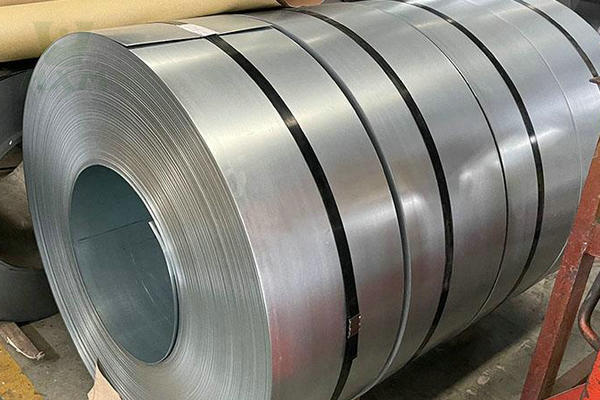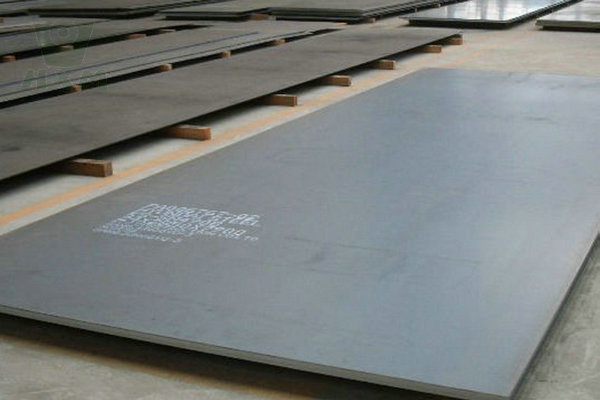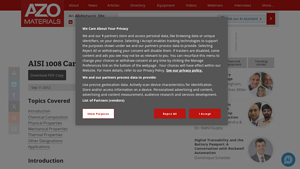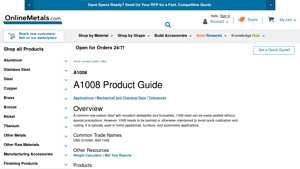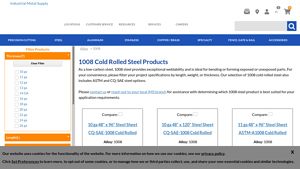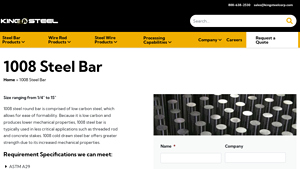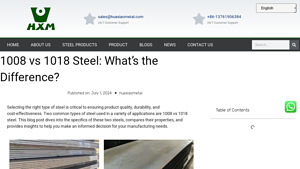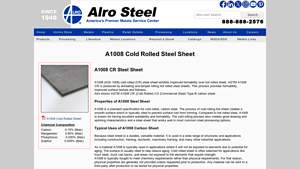1008 Carbon Steel Guide: Type, Cost, Top List…
Introduction: Navigating the Global Market for 1008 carbon steel
Navigating the complexities of sourcing 1008 carbon steel can pose significant challenges for international B2B buyers, especially in rapidly evolving markets across Africa, South America, the Middle East, and Europe. This low-carbon steel is renowned for its excellent weldability and formability, making it a favored choice in various industries, including automotive, home appliances, and furniture manufacturing. However, ensuring the right material specifications, quality compliance, and competitive pricing can be daunting for businesses aiming to maintain a competitive edge.
This comprehensive guide aims to demystify the global market for 1008 carbon steel by exploring its diverse types, applications, and mechanical properties. It will provide actionable insights into effective supplier vetting processes, enabling buyers to identify reputable manufacturers and distributors that align with their operational needs. Additionally, the guide will delve into cost analysis, helping businesses make informed purchasing decisions that maximize value while minimizing risk.
By equipping B2B buyers with essential knowledge and practical tools, this guide empowers them to navigate the intricacies of sourcing 1008 carbon steel efficiently. Whether you’re based in Saudi Arabia or Vietnam, understanding the nuances of this material will enhance your procurement strategy and foster long-term partnerships in a competitive marketplace.
Understanding 1008 carbon steel Types and Variations
| Type Name | Key Distinguishing Features | Primary B2B Applications | Brief Pros & Cons for Buyers |
|---|---|---|---|
| Cold Rolled 1008 | Smooth surface finish, tighter tolerances, superior strength | Automotive parts, furniture, appliances | Pros: Excellent formability; Cons: Prone to rust without treatment. |
| Hot Rolled 1008 | Rougher surface, lower strength than cold rolled | Structural components, machinery | Pros: Cost-effective; Cons: Less precise dimensions. |
| 1008 Steel Sheet | Thin, flat sheets available in various gauges | HVAC systems, general fabrication | Pros: Versatile for many applications; Cons: Requires surface protection. |
| 1008 Steel Plate | Thicker and heavier than sheets, high load-bearing capacity | Heavy machinery, construction | Pros: High durability; Cons: More expensive than sheets. |
| 1008 Steel Coil | Continuous roll form, easy to handle and transport | Manufacturing, stamping processes | Pros: Reduces waste; Cons: Requires cutting for specific applications. |
What Are the Characteristics and Suitability of Cold Rolled 1008 Steel?
Cold rolled 1008 steel is known for its smooth surface finish and tighter dimensional tolerances compared to its hot rolled counterpart. This type is ideal for applications that require a combination of strength and aesthetic appeal, such as automotive parts and consumer appliances. When purchasing, consider the need for surface protection against corrosion, as this steel can rust if not properly coated.
How Does Hot Rolled 1008 Steel Differ From Other Variants?
Hot rolled 1008 steel features a rougher surface and is generally less expensive than cold rolled steel. It is suitable for structural components and heavy machinery where precise dimensions are less critical. Buyers should weigh the cost savings against the potential need for additional surface finishing, as it may require further treatment to enhance durability.
What Are the Applications and Benefits of 1008 Steel Sheets?
1008 steel sheets are versatile and available in various gauges, making them suitable for HVAC systems and general fabrication tasks. Their thin profile allows for easy manipulation, but buyers must consider the necessity of protective coatings to prevent oxidation. The adaptability of these sheets makes them a popular choice among manufacturers.
Why Choose 1008 Steel Plates for Heavy-Duty Applications?
1008 steel plates are thicker and designed for high-load applications, such as in construction and heavy machinery. Their robust nature provides durability and longevity, making them a valuable investment. However, potential buyers should be aware that these plates can be more expensive than their sheet counterparts, impacting overall project budgets.
What Advantages Do 1008 Steel Coils Offer in Manufacturing?
1008 steel coils are supplied in a continuous roll form, which facilitates easy handling and transportation. This format is particularly advantageous in manufacturing and stamping processes, as it minimizes waste. Buyers should consider their cutting and processing needs, as coils may require additional steps before use in specific applications.
Key Industrial Applications of 1008 carbon steel
| Industry/Sector | Specific Application of 1008 carbon steel | Value/Benefit for the Business | Key Sourcing Considerations for this Application |
|---|---|---|---|
| Home Appliances | Fabrication of appliance frames | Cost-effective, lightweight yet strong materials | Ensure compliance with local standards and regulations |
| Furniture Manufacturing | Production of metal furniture | Durable and aesthetically pleasing products | Look for suppliers offering custom sizes and finishes |
| Automotive | Components in vehicle manufacturing | High strength-to-weight ratio for improved efficiency | Assess quality certifications and delivery timelines |
| Construction | Structural elements in buildings | Versatile material suitable for various structures | Verify availability of different thicknesses and grades |
| Electrical Enclosures | Housing for electrical components | Excellent weldability for secure assembly | Ensure rust-resistant options are available |
How is 1008 Carbon Steel Used in Home Appliances?
In the home appliance sector, 1008 carbon steel is primarily utilized for creating robust frames and structural components. Its excellent weldability allows for seamless assembly, which is crucial in manufacturing processes. Businesses in this sector benefit from the material’s lightweight properties, reducing overall production costs while maintaining strength. International buyers should prioritize suppliers who understand local compliance regulations to ensure product safety and reliability.
What Role Does 1008 Carbon Steel Play in Furniture Manufacturing?
In furniture manufacturing, 1008 carbon steel is favored for its durability and formability, making it ideal for both indoor and outdoor furniture. Manufacturers leverage this material to create stylish and sturdy designs that can withstand heavy use. Buyers should consider sourcing from suppliers who offer customization options to meet specific design requirements and aesthetic preferences. Additionally, understanding the finishes available can help mitigate rust issues, especially in humid climates.
How is 1008 Carbon Steel Applied in the Automotive Industry?
The automotive industry utilizes 1008 carbon steel for various components, including brackets and frames, due to its high strength-to-weight ratio. This characteristic enhances vehicle efficiency by reducing overall weight without compromising structural integrity. International B2B buyers should focus on suppliers who can provide certified materials that meet stringent automotive standards. Timely delivery and the ability to accommodate large orders are also critical factors for successful sourcing.
Why is 1008 Carbon Steel Important in Construction?
In construction, 1008 carbon steel is used for structural elements like beams and reinforcements due to its versatility and strength. Its formability allows it to be shaped into various profiles, making it suitable for different architectural designs. Buyers in the construction sector must ensure that their suppliers can provide a range of thicknesses and grades to meet specific project requirements. Additionally, assessing the supplier’s ability to handle large-scale orders is essential for project timelines.
How is 1008 Carbon Steel Used in Electrical Enclosures?
1008 carbon steel is commonly employed in the production of electrical enclosures, providing a robust housing solution for sensitive components. Its excellent weldability ensures secure assembly, which is vital for protecting electrical systems from environmental factors. Buyers should seek suppliers that offer rust-resistant coatings to prolong the life of the enclosures, especially in regions with high humidity. Additionally, understanding the electrical standards in their region can guide sourcing decisions effectively.
3 Common User Pain Points for ‘1008 carbon steel’ & Their Solutions
Scenario 1: Difficulty in Sourcing Quality 1008 Carbon Steel
The Problem:
B2B buyers often face challenges when trying to source high-quality 1008 carbon steel. In regions such as Africa and South America, limited access to reliable suppliers can lead to inconsistent quality, which in turn affects production timelines and project integrity. Buyers may struggle with inadequate product information, leading to uncertainty about material properties like tensile strength and weldability. This can result in costly delays, rework, and ultimately, a loss of trust from clients relying on their products.
The Solution:
To overcome sourcing issues, buyers should establish relationships with reputable suppliers who specialize in 1008 carbon steel. Conduct thorough research to verify suppliers’ certifications and track records in delivering consistent quality. Use platforms that provide detailed product specifications, including mechanical properties, chemical composition, and compliance with relevant industry standards like ASTM A1008. Furthermore, consider requesting samples or small test orders before committing to larger quantities. This proactive approach not only ensures material quality but also builds a foundation for long-term supplier partnerships.
Scenario 2: Challenges in Fabrication and Machining of 1008 Carbon Steel
The Problem:
Fabricators often find it challenging to work with 1008 carbon steel due to its specific machining and fabrication properties. While it is known for its excellent weldability and formability, improper handling can lead to issues such as warping or inadequate surface finish. Additionally, buyers may not have the right equipment or techniques to effectively cut, bend, or shape this material, which can delay production and increase costs.
The Solution:
To address fabrication challenges, buyers should invest in proper training for their team on the specific properties and handling requirements of 1008 carbon steel. Utilize cutting tools that are optimized for low-carbon steels, such as high-speed steel or carbide tools, to achieve better results. Additionally, implementing best practices for machining—such as maintaining appropriate feed rates and using lubrication—can significantly improve the final output. Buyers can also collaborate with experienced fabricators who have a proven track record in working with 1008 steel, allowing them to leverage expertise and reduce errors in the fabrication process.
Scenario 3: Corrosion and Maintenance Issues with 1008 Carbon Steel
The Problem:
One of the prominent concerns for B2B buyers using 1008 carbon steel is its susceptibility to corrosion, especially in humid or coastal environments. Without proper maintenance or protective coatings, components made from this material can quickly oxidize and deteriorate, leading to increased replacement costs and potential safety hazards. This is particularly relevant for industries such as automotive and home appliance manufacturing, where product longevity is critical.
The Solution:
To mitigate corrosion risks, it is essential for buyers to specify protective treatments for 1008 carbon steel. Options include galvanization, powder coating, or applying anti-corrosive paint, depending on the application and environment. Regular maintenance schedules should be established to inspect and treat any exposed areas, ensuring long-term durability of the products. Additionally, educating end-users on proper care and maintenance of products made from 1008 steel can significantly enhance the material’s lifespan. By integrating these strategies, buyers can not only protect their investment but also improve customer satisfaction through reliable product performance.
Strategic Material Selection Guide for 1008 carbon steel
What Are the Key Properties of 1008 Carbon Steel?
1008 carbon steel is a low-carbon steel alloy known for its excellent weldability and formability. Its mechanical properties include a yield strength ranging from 26.1 to 34.8 ksi and an ultimate tensile strength of 49.9 to 51.9 ksi. The material exhibits good elongation at break (42-48%), allowing it to be easily shaped without fracturing. However, it is important to note that 1008 steel has limited corrosion resistance, necessitating protective coatings or regular maintenance to prevent rusting. This makes it suitable for applications in environments where exposure to moisture is controlled.
What Are the Advantages and Disadvantages of Using 1008 Carbon Steel?
One of the primary advantages of 1008 carbon steel is its cost-effectiveness. It is generally less expensive than higher-carbon steels and alloys, making it an attractive option for budget-conscious projects. Its excellent weldability also simplifies manufacturing processes, allowing for efficient assembly in various applications, such as home appliances and automotive components.
However, the main disadvantage of 1008 carbon steel is its susceptibility to corrosion. Without appropriate protective measures, it can oxidize quickly, leading to premature failure in outdoor or humid environments. Additionally, while it is easy to machine, its lower hardness compared to higher-carbon steels may limit its use in high-stress applications.
How Does 1008 Carbon Steel Impact Application Suitability?
In terms of application, 1008 carbon steel is particularly well-suited for products that require bending, forming, and welding. Its properties make it ideal for manufacturing furniture, automotive parts, and household appliances. However, industries operating in regions with high humidity or corrosive environments must consider protective coatings or alternative materials to ensure longevity and performance.
International B2B buyers, especially from regions like Africa, South America, the Middle East, and Europe, should also be aware of compliance with local standards. For example, ASTM A1008 is a common specification for this material, and understanding local regulations regarding material quality and safety can help avoid costly delays.
What Should International Buyers Consider When Sourcing 1008 Carbon Steel?
When sourcing 1008 carbon steel, international buyers should consider logistics and supply chain factors, including shipping costs and lead times. Suppliers should be able to provide documentation that meets local compliance standards, such as ASTM, DIN, or JIS. Additionally, buyers should evaluate the supplier’s ability to provide custom cuts or specific dimensions to meet project requirements, as this can significantly impact manufacturing efficiency.
| Material | Typical Use Case for 1008 carbon steel | Key Advantage | Key Disadvantage/Limitation | Relative Cost (Low/Med/High) |
|---|---|---|---|---|
| 1008 Carbon Steel | Automotive parts, furniture, appliances | Excellent weldability and formability | Susceptible to corrosion | Low |
| 1018 Carbon Steel | Structural components, gears | Higher hardness, better wear resistance | More expensive than 1008 | Medium |
| Stainless Steel (304) | Food processing equipment, marine applications | Superior corrosion resistance | Higher cost, more difficult to weld | High |
| Aluminum | Lightweight structures, packaging | Lightweight and corrosion-resistant | Lower strength compared to steel | Medium |
This analysis provides a comprehensive overview of 1008 carbon steel, highlighting its properties, advantages, and limitations, while also addressing considerations for international B2B buyers. Understanding these factors is essential for making informed material selection decisions that align with specific project requirements.
In-depth Look: Manufacturing Processes and Quality Assurance for 1008 carbon steel
What Are the Key Manufacturing Processes for 1008 Carbon Steel?
The manufacturing of 1008 carbon steel involves several critical stages, each designed to ensure the material meets the required specifications for various applications. The primary stages include material preparation, forming, assembly, and finishing.
How is Material Prepared for 1008 Carbon Steel Production?
Material preparation begins with sourcing high-quality raw materials. For 1008 carbon steel, this typically involves the selection of iron ore and scrap steel. These materials undergo a refining process to remove impurities and achieve the desired chemical composition, primarily focusing on a low carbon content of around 0.08%.
Once the materials are refined, they are melted in an electric arc furnace (EAF) or a basic oxygen furnace (BOF). The molten steel is then cast into slabs or billets, which are cooled and solidified. This initial stage is crucial, as the quality of the raw materials directly impacts the final product’s mechanical properties and performance.
What Techniques are Used in the Forming Process of 1008 Carbon Steel?
The forming process for 1008 carbon steel typically involves cold rolling, which enhances the material’s mechanical properties, such as strength and hardness, while maintaining its ductility. Cold rolling is performed by passing the steel through a series of rollers at room temperature. This method not only shapes the steel but also improves surface finish and dimensional accuracy.
In addition to cold rolling, other forming techniques may include stamping, bending, and deep drawing, depending on the intended application. For instance, in automotive manufacturing, 1008 carbon steel is often used for components that require intricate shapes and high precision, such as body panels and structural supports.
How is the Assembly Process Conducted for 1008 Carbon Steel Products?
The assembly of products made from 1008 carbon steel involves various joining methods, primarily welding and mechanical fastening. Given the excellent weldability of this steel grade, it can be easily welded using standard techniques without the need for special precautions. This makes it a favorable choice for applications in home appliances, furniture, and automotive components.
Mechanical fastening methods, such as riveting and bolting, are also common, particularly in applications where disassembly may be required for maintenance or repair. Ensuring proper assembly techniques is crucial to maintaining the integrity and performance of the final product.
What Finishing Processes are Commonly Used for 1008 Carbon Steel?
Finishing processes for 1008 carbon steel are essential to protect against corrosion and enhance appearance. The most common finishing techniques include painting, galvanizing, and powder coating. Since 1008 carbon steel is prone to oxidization, applying a protective coating is vital to prolong its lifespan, especially in outdoor or harsh environments.
Additionally, surface treatments such as annealing may be employed to relieve internal stresses and improve ductility. These finishing processes not only enhance the aesthetic appeal of the products but also significantly contribute to their durability and performance.
What Quality Assurance Measures Are Essential for 1008 Carbon Steel?
Quality assurance (QA) is a critical aspect of manufacturing 1008 carbon steel, ensuring that products meet international standards and customer specifications. The QA process typically adheres to ISO 9001 standards, which provide a framework for consistent quality management practices.
Which International Standards Should B2B Buyers Be Aware Of?
B2B buyers should be familiar with several relevant international standards that govern the quality of 1008 carbon steel. In addition to ISO 9001, certifications such as CE (Conformité Européenne) and API (American Petroleum Institute) are essential for specific applications, particularly in the automotive and oil and gas industries.
These certifications not only ensure compliance with safety and performance standards but also signify that the manufacturer employs robust quality control systems throughout the production process.
What Are the Key QC Checkpoints in the Manufacturing of 1008 Carbon Steel?
Quality control checkpoints are integral to the manufacturing process and typically include Incoming Quality Control (IQC), In-Process Quality Control (IPQC), and Final Quality Control (FQC).
- IQC involves inspecting raw materials upon arrival to ensure they meet specified standards before production begins.
- IPQC focuses on monitoring the production process, identifying any deviations from quality standards, and implementing corrective actions in real-time.
- FQC is the final inspection stage, where finished products are tested for compliance with specifications and performance standards before shipment.
Common testing methods employed include tensile testing, hardness testing, and impact testing, which evaluate the mechanical properties of the steel.
How Can B2B Buyers Verify Supplier Quality Control Practices?
B2B buyers, particularly those in regions like Africa, South America, the Middle East, and Europe, should take proactive measures to verify the quality control practices of their suppliers. This can be achieved through several approaches:
-
Supplier Audits: Conducting regular audits of suppliers can provide insights into their manufacturing processes and quality control systems. This is crucial for ensuring compliance with international standards and identifying potential risks.
-
Reviewing Quality Reports: Requesting detailed quality reports, including test results and compliance certifications, can help buyers assess the reliability of the supplier’s products.
-
Third-Party Inspections: Engaging third-party inspection services can offer an unbiased evaluation of the supplier’s quality control measures. These inspections can verify that the products meet the required standards before they are shipped.
-
Understanding Certification Nuances: Buyers should be aware of the specific certification requirements in their regions. For instance, certifications recognized in Europe may differ from those in the Middle East or Africa, and understanding these nuances is essential for ensuring compliance.
Conclusion
The manufacturing processes and quality assurance measures for 1008 carbon steel play a vital role in delivering high-quality products that meet the needs of various industries. By understanding these processes and implementing robust quality control practices, B2B buyers can ensure they source reliable materials that enhance their operations and drive business success.
Practical Sourcing Guide: A Step-by-Step Checklist for ‘1008 carbon steel’
This practical sourcing guide is designed to assist B2B buyers in the procurement of 1008 carbon steel, a low-carbon steel known for its excellent weldability and formability. Whether you’re sourcing for automotive, furniture, or home appliance applications, following this checklist will help ensure a smooth and effective purchasing process.
Step 1: Define Your Technical Specifications
Clearly outline your technical requirements for 1008 carbon steel, including dimensions, thickness, and quantity. This step is crucial as it will guide your supplier search and ensure you receive materials that meet your project needs. Consider factors such as ultimate tensile strength, yield strength, and specific applications to avoid compatibility issues later on.
Step 2: Research Potential Suppliers
Conduct thorough research to identify suppliers that specialize in 1008 carbon steel. Look for companies with established reputations and proven experience in your industry. Utilize online resources, industry directories, and trade shows to gather a list of potential partners that align with your sourcing goals.
Step 3: Evaluate Supplier Certifications
Verify that potential suppliers hold relevant certifications and comply with industry standards, such as ISO 9001 or ASTM specifications. Certifications demonstrate a commitment to quality and regulatory compliance, which is vital for ensuring the reliability of the materials you procure. Request documentation to confirm their certification status and quality control processes.
Step 4: Request Samples for Testing
Before making a bulk purchase, request samples of 1008 carbon steel for quality testing. This is an essential step to evaluate the material’s properties and ensure it meets your specific requirements. Conduct tests for weldability, formability, and hardness to ascertain that the steel will perform as needed in your applications.
Step 5: Assess Pricing and Terms of Sale
Gather quotes from multiple suppliers to compare pricing and payment terms. Pay attention to additional costs such as shipping, handling, and potential tariffs, especially when sourcing from international suppliers. Understanding the total cost of ownership will help you make informed financial decisions and negotiate better terms.
Step 6: Check Delivery Capabilities
Ensure that the supplier can meet your delivery requirements, including timelines and logistics. Confirm their ability to handle international shipping if you are sourcing from abroad. Reliable delivery is crucial to maintaining your production schedules and avoiding costly delays.
Step 7: Establish Communication Channels
Set up clear communication channels with your chosen supplier to facilitate ongoing dialogue. Discuss expectations regarding order status updates, quality issues, and return policies. Effective communication can help prevent misunderstandings and ensure a successful long-term partnership.
By following these steps, B2B buyers can effectively navigate the sourcing process for 1008 carbon steel, ensuring they secure high-quality materials that meet their operational needs while fostering strong supplier relationships.
Comprehensive Cost and Pricing Analysis for 1008 carbon steel Sourcing
What Are the Key Cost Components for 1008 Carbon Steel Sourcing?
When evaluating the cost structure for sourcing 1008 carbon steel, several components come into play. Material costs are foundational, influenced by the global price of raw steel, which can fluctuate based on market demand and geopolitical factors. Labor costs associated with processing and fabricating the steel, including wages and benefits for skilled workers, also contribute significantly to the overall pricing. Additionally, manufacturing overhead—which encompasses utilities, equipment maintenance, and facility costs—adds another layer to the cost structure.
Tooling costs are essential, particularly if custom shapes or sizes are required. This includes expenses related to molds, dies, and other specialized equipment. Quality control (QC) measures must also be factored in, ensuring that the steel meets the necessary specifications and certifications for international markets. Finally, logistics costs, including shipping and handling, play a critical role, especially for international buyers who must consider customs duties and tariffs.
How Do Price Influencers Affect 1008 Carbon Steel Costs?
Several factors can influence the pricing of 1008 carbon steel. Volume and minimum order quantities (MOQ) are significant; larger orders often result in lower per-unit costs due to economies of scale. Customization, such as specific dimensions or additional treatments, may increase costs as well, depending on the complexity of the requirements.
Material quality and certifications can also impact pricing. Buyers seeking certified materials for high-stakes applications may pay a premium for assurance of quality. Supplier factors, including their reputation, reliability, and historical pricing trends, should not be overlooked. Lastly, Incoterms dictate the responsibilities of buyers and sellers in international trade, influencing overall cost and risk management.
What Buyer Tips Can Help in Negotiating Prices for 1008 Carbon Steel?
To enhance cost-efficiency and secure favorable pricing, buyers should approach negotiations with a comprehensive understanding of the Total Cost of Ownership (TCO). This concept goes beyond the initial purchase price to include long-term factors such as maintenance, lifecycle costs, and the potential for waste or rework.
In negotiations, leverage volume commitments or long-term contracts to negotiate lower prices or better terms. Don’t hesitate to request quotes from multiple suppliers to establish a competitive benchmark. Additionally, be aware of pricing nuances associated with international sourcing. Factors such as currency fluctuations, local market conditions, and regional supply chain dynamics can significantly affect final costs.
It’s also crucial to consider the implications of logistics on pricing. Understanding shipping routes, lead times, and potential delays can help avoid unexpected costs. Moreover, ensure clarity on Incoterms to mitigate misunderstandings regarding who bears responsibility for shipping and customs.
What Should Buyers Keep in Mind Regarding Indicative Prices for 1008 Carbon Steel?
While indicative prices can provide a useful starting point for budget discussions, it is essential to recognize that actual costs may vary significantly based on the factors mentioned above. Global market trends, local supply and demand conditions, and the specific requirements of a project can all lead to price fluctuations. Therefore, continuous market research and supplier engagement are vital in obtaining the most accurate and competitive pricing for 1008 carbon steel.
By understanding the intricacies of cost components, price influencers, and effective negotiation strategies, B2B buyers can optimize their sourcing process, ensuring they secure high-quality materials at competitive prices while minimizing risk and maximizing value.
Alternatives Analysis: Comparing 1008 carbon steel With Other Solutions
Understanding Alternatives to 1008 Carbon Steel
In the competitive landscape of metal materials, selecting the right solution is paramount for businesses aiming for efficiency, cost-effectiveness, and quality. 1008 carbon steel is a popular choice due to its excellent weldability and formability; however, various alternatives exist that may better suit specific applications or requirements. This section compares 1008 carbon steel with other viable materials, enabling B2B buyers to make informed decisions.
Comparison Table
| Comparison Aspect | 1008 Carbon Steel | Alternative 1: 1018 Carbon Steel | Alternative 2: Stainless Steel (304) |
|---|---|---|---|
| Performance | Good weldability and formability | Higher tensile strength, moderate formability | Excellent corrosion resistance, high tensile strength |
| Cost | Generally lower cost | Slightly higher than 1008 | Higher cost due to alloying elements |
| Ease of Implementation | Easy to work with; minimal training required | Similar ease of implementation | Requires specialized tools for cutting and welding |
| Maintenance | Prone to rust; needs protective coatings | Better rust resistance, less maintenance | Low maintenance; excellent corrosion resistance |
| Best Use Case | Automotive parts, furniture | Machinery parts, structural applications | Food processing, marine applications |
Detailed Breakdown of Alternatives
1018 Carbon Steel
1018 carbon steel is an alternative that offers superior tensile strength compared to 1008. This makes it ideal for applications requiring enhanced load-bearing capabilities, such as machinery parts and structural components. While it is slightly more expensive, its improved mechanical properties can justify the cost for applications where strength is paramount. However, it shares similar maintenance requirements, needing protective coatings to prevent rust.
Stainless Steel (304)
Stainless steel, particularly the 304 grade, presents a compelling alternative due to its excellent corrosion resistance and high tensile strength. While it is more expensive than 1008 and 1018 carbon steels, its durability and low maintenance make it suitable for demanding environments such as food processing and marine applications. The trade-off is that it may require specialized tools for fabrication, which could increase initial implementation costs. However, the long-term savings in maintenance and longevity can offset these initial investments.
Conclusion: How to Choose the Right Solution for Your Needs
When selecting between 1008 carbon steel and its alternatives, B2B buyers should consider several factors, including the specific application requirements, budget constraints, and long-term maintenance needs. While 1008 carbon steel is an excellent choice for projects demanding good weldability and lower costs, alternatives like 1018 carbon steel and stainless steel may offer advantages in strength and corrosion resistance, albeit at a higher price. By evaluating the performance characteristics and cost implications of each option, buyers can make a well-informed decision tailored to their unique operational needs.
Essential Technical Properties and Trade Terminology for 1008 carbon steel
What Are the Key Technical Properties of 1008 Carbon Steel?
Understanding the technical specifications of 1008 carbon steel is essential for B2B buyers, particularly those involved in manufacturing and fabrication across various industries. Here are some critical specifications:
-
Material Grade: 1008 is classified as a low-carbon steel, commonly recognized by its AISI designation. This grade indicates a carbon content of approximately 0.08%, which provides excellent ductility and weldability. For buyers, selecting the right material grade ensures compatibility with specific applications, such as automotive parts or home appliances.
-
Yield Strength: The yield strength of 1008 carbon steel ranges from 26.1 to 34.8 ksi (kilopounds per square inch). This property is crucial as it indicates the maximum stress the material can withstand without permanent deformation. For manufacturers, knowing the yield strength helps in determining the load-bearing capacity of components, ensuring safety and reliability in applications.
-
Ultimate Tensile Strength: With a tensile strength between 49.9 and 51.9 ksi, this property signifies the material’s ability to resist being pulled apart. For B2B buyers, understanding tensile strength is vital for applications where the steel will face tensile forces, such as in structural components or machinery.
-
Elongation at Break: This property measures how much the material can stretch before breaking, with 1008 exhibiting an elongation of 42-48%. A higher elongation percentage indicates greater ductility, making it suitable for forming processes. This is particularly beneficial in industries where complex shapes are required, such as in automotive or furniture manufacturing.
-
Hardness: 1008 carbon steel typically has a Rockwell hardness of B55 and a Brinell hardness of 95. Hardness affects wear resistance and machining capabilities. For buyers, this is a critical factor when selecting materials that will undergo wear or require machining.
-
Machinability: Rated at 55%, 1008 offers moderate machinability. This property is significant for manufacturers who require precise machining and forming processes. Understanding machinability helps in selecting appropriate tools and processes, ultimately reducing production costs.
What Are Common Trade Terms Related to 1008 Carbon Steel?
Familiarity with industry-specific terminology can enhance communication and negotiations between B2B buyers and suppliers. Here are some common trade terms:
-
OEM (Original Equipment Manufacturer): This term refers to companies that produce parts or equipment that may be marketed by another manufacturer. In the context of 1008 carbon steel, OEMs often require specific material grades and specifications for their products.
-
MOQ (Minimum Order Quantity): MOQ represents the minimum amount of a product that a supplier is willing to sell. For buyers, understanding MOQ is crucial when planning inventory purchases and managing supply chain logistics, particularly in international transactions.
-
RFQ (Request for Quotation): An RFQ is a document issued by buyers to solicit price quotes from suppliers. It typically includes detailed specifications, quantities, and delivery requirements. For B2B buyers, submitting a precise RFQ can lead to better pricing and terms.
-
Incoterms: These are international commercial terms that define the responsibilities of buyers and sellers in shipping and freight. Understanding Incoterms is essential for B2B buyers to clarify liability and costs associated with transportation and delivery of 1008 carbon steel products.
-
Lead Time: This term refers to the time it takes from placing an order to receiving it. For buyers, knowing the lead time helps in planning production schedules and inventory management, especially when sourcing materials from different regions.
-
Certification: This term refers to documentation proving that a product meets specified standards and regulations. For buyers, ensuring that 1008 carbon steel comes with the necessary certifications is vital for compliance and quality assurance in various applications.
By grasping these technical properties and trade terms, B2B buyers can make informed decisions, negotiate effectively, and ensure the successful integration of 1008 carbon steel into their operations.
Navigating Market Dynamics and Sourcing Trends in the 1008 carbon steel Sector
What Are the Current Market Dynamics and Key Trends in the 1008 Carbon Steel Sector?
The global market for 1008 carbon steel is influenced by various factors, including economic growth, industrialization, and advancements in manufacturing technologies. As countries in Africa, South America, the Middle East, and Europe continue to develop, the demand for low-carbon steels, such as 1008, is anticipated to rise. Key trends include the growing emphasis on automation and digitalization in manufacturing processes, which enhances efficiency and reduces costs. Additionally, the rise of e-commerce platforms is facilitating easier access for international B2B buyers to source materials, making it crucial for suppliers to optimize their online presence and logistics capabilities.
Emerging technologies, such as advanced analytics and artificial intelligence, are also transforming sourcing strategies. B2B buyers can leverage data-driven insights to make informed decisions about their supply chains, identifying optimal suppliers and managing inventory levels more effectively. Furthermore, the shift towards just-in-time manufacturing practices is prompting companies to maintain leaner inventories and rely on suppliers who can offer flexible, responsive service.
In regions like Saudi Arabia and Vietnam, government initiatives aimed at boosting local manufacturing capabilities are influencing sourcing trends. Buyers are increasingly looking to partner with local suppliers to reduce lead times and transportation costs, while also supporting regional economies. Understanding these dynamics is essential for international B2B buyers to navigate the complexities of the 1008 carbon steel market effectively.
How Important Are Sustainability and Ethical Sourcing in the 1008 Carbon Steel Industry?
Sustainability and ethical sourcing are becoming paramount concerns for B2B buyers in the 1008 carbon steel sector. As industries globally strive to minimize their environmental impact, the demand for sustainable materials and practices is increasing. Buyers are now more inclined to partner with suppliers who demonstrate a commitment to reducing carbon emissions and implementing responsible manufacturing processes.
The environmental impact of steel production is significant, contributing to greenhouse gas emissions and resource depletion. Therefore, sourcing from suppliers who utilize renewable energy sources or implement energy-efficient technologies can greatly enhance a company’s sustainability profile. Certifications like ISO 14001 for environmental management systems are becoming vital indicators of a supplier’s commitment to sustainability.
Moreover, the importance of ethical supply chains cannot be overstated. Buyers are increasingly scrutinizing their suppliers’ labor practices and sourcing methods to ensure compliance with ethical standards. This scrutiny extends to the sourcing of raw materials, prompting companies to seek suppliers who can guarantee responsible practices throughout the supply chain. By prioritizing sustainability and ethical sourcing, B2B buyers can not only reduce their environmental footprint but also enhance their brand reputation and appeal to socially conscious consumers.
What Is the Evolution of 1008 Carbon Steel in the B2B Market?
The evolution of 1008 carbon steel can be traced back to its introduction as a low-carbon steel alternative, providing excellent weldability and formability. Initially popular in the automotive and appliance industries, its versatility has led to its adoption in various sectors, including furniture and construction. Over time, technological advancements in steel production and processing have enhanced its mechanical properties, making it a preferred choice for manufacturers seeking cost-effective solutions without compromising quality.
In recent years, the rise of digital technologies has transformed the sourcing landscape, allowing B2B buyers to access detailed product information and supplier evaluations with ease. This shift has not only improved transparency but has also fostered competitive pricing and innovation within the sector. As industries continue to evolve, the role of 1008 carbon steel is expected to expand, driven by ongoing advancements in manufacturing technologies and a growing focus on sustainable practices.
Frequently Asked Questions (FAQs) for B2B Buyers of 1008 carbon steel
-
How do I evaluate the quality of 1008 carbon steel suppliers?
To evaluate the quality of suppliers for 1008 carbon steel, consider their certifications, such as ISO 9001 or ASTM compliance. Request mill test reports to confirm the steel’s chemical and mechanical properties. Additionally, check customer reviews and references to gauge their reliability and service levels. Conduct site visits if possible, and inquire about their manufacturing processes and quality assurance measures. This thorough vetting will help ensure you partner with a reputable supplier. -
What are the common applications of 1008 carbon steel?
1008 carbon steel is widely used in various industries due to its excellent weldability and formability. Common applications include home appliances, automotive components, and furniture manufacturing. Its low carbon content makes it suitable for bending and shaping without cracking. Understanding the specific application requirements will help you select the right form and grade of 1008 steel for your project. -
What customization options are available for 1008 carbon steel products?
Many suppliers offer customization options for 1008 carbon steel, including cutting to size, specific thicknesses, and surface treatments. Depending on your needs, you can request custom shapes, finishes, or coatings to enhance durability and corrosion resistance. Discuss your project specifications with potential suppliers to ensure they can meet your requirements and provide tailored solutions. -
What are the minimum order quantities (MOQs) for 1008 carbon steel?
Minimum order quantities for 1008 carbon steel can vary significantly by supplier and region. Typically, MOQs can range from a few hundred kilograms to several tons, especially for customized orders. It’s advisable to confirm MOQs with your supplier early in the procurement process to ensure they align with your project needs and budget. -
What payment terms should I expect when sourcing 1008 carbon steel internationally?
Payment terms can vary by supplier and region but commonly include options such as net 30, net 60, or cash in advance. For international transactions, consider using letters of credit or escrow services to mitigate risks. Always clarify payment terms upfront and ensure they are documented in your purchase agreement to avoid any misunderstandings later. -
How should I manage logistics when importing 1008 carbon steel?
Managing logistics for importing 1008 carbon steel involves coordinating shipping, customs clearance, and delivery to your location. Work closely with your supplier to determine the best shipping method, considering factors like cost, delivery time, and reliability. Engage a freight forwarder experienced in handling steel imports to navigate customs regulations and ensure timely delivery. -
What quality assurance measures should be in place for 1008 carbon steel products?
Quality assurance measures for 1008 carbon steel should include regular inspections and testing of the steel’s mechanical properties, such as tensile strength and hardness. Suppliers should provide certification and mill test reports to confirm compliance with industry standards. Establish a quality control protocol to inspect received materials and ensure they meet your specifications and performance requirements. -
How do I address potential corrosion issues with 1008 carbon steel?
To mitigate corrosion risks with 1008 carbon steel, consider applying protective coatings, such as paint or galvanization, especially if the steel will be exposed to moisture or harsh environments. Regular maintenance and inspections can help identify early signs of rust or deterioration. Additionally, evaluate the environmental conditions where the steel will be used to determine the best protective measures to extend its lifespan.
Important Disclaimer & Terms of Use
⚠️ Important Disclaimer
The information provided in this guide, including content regarding manufacturers, technical specifications, and market analysis, is for informational and educational purposes only. It does not constitute professional procurement advice, financial advice, or legal advice.
While we have made every effort to ensure the accuracy and timeliness of the information, we are not responsible for any errors, omissions, or outdated information. Market conditions, company details, and technical standards are subject to change.
B2B buyers must conduct their own independent and thorough due diligence before making any purchasing decisions. This includes contacting suppliers directly, verifying certifications, requesting samples, and seeking professional consultation. The risk of relying on any information in this guide is borne solely by the reader.
Top 7 1008 Carbon Steel Manufacturers & Suppliers List
1. AISI 1008 Carbon Steel – Key Properties
Domain: azom.com
Registered: 1999 (26 years)
Introduction: AISI 1008 Carbon Steel (UNS G10080) is a carbon steel primarily composed of iron (99.31-99.7%), manganese (0.30-0.50%), carbon (0.10%), sulfur (0.050%), and phosphorus (0.040%). It has excellent weldability and is used in extruded, cold headed, cold upset, and cold pressed parts. The physical properties include a density of 7.872 g/cm³. Mechanical properties include a tensile strength of 340 MPa, …
2. Online Metals – A1008 Cold Rolled Steel
Domain: onlinemetals.com
Registered: 1997 (28 years)
Introduction: A1008 is a cold rolled steel alloy known for its excellent surface finish and high strength. It is commonly used in applications requiring good formability and weldability. The alloy has a low carbon content, which enhances its ductility and makes it suitable for various manufacturing processes. Typical applications include automotive parts, appliances, and furniture. A1008 is available in various…
3. Industrial Metal Supply – 1008 Aluminum & Low-Carbon Steel
Domain: industrialmetalsupply.com
Registered: 1999 (26 years)
Introduction: 1008 Aluminum | ASTM A1008 | CQ-SAE-1008 | Low-carbon steel providing exceptional weldability | Ideal for bending or forming exposed or unexposed parts | Available in metal sheets & plates | Custom cutting options available | Locations: Inland Empire, Los Angeles, Orange County, San Diego, San Jose, Phoenix, Tucson | Services: Request a services quote, cut to size, high definition plasma, flatbed …
4. King Steel Corp – Low Carbon Steel Bars
Domain: kingsteelcorp.com
Registered: 1999 (26 years)
Introduction: 1008 Steel Bar
– Size Range: 1/4″ to 15″
– Material: Low carbon steel
– Applications: Threaded rod, concrete stakes
– Mechanical Properties: Lower mechanical properties for less critical applications; increased strength in cold drawn version
– Requirement Specifications: ASTM A29, ASTM A576, JDM QL-2 certified
– Available Shapes: Rounds, Square, Hexagon, Rounded Cornered Square, Flats
Hot Rolled …
5. Huaxiao Metal – Low Carbon Steel & AISI 1018 Carbon Steel
Domain: huaxiaometal.com
Registered: 2014 (11 years)
Introduction: 1008 Steel: Premium Low Carbon Steel, excellent weldability and formability, ideal for various applications. 1018 Steel: AISI 1018 Carbon Steel, available products include Round Bar, Flat Bar, Square Bar, Hexagon Bar, Plate, Coil, Tube, and more. Chemical Composition: 1008 Steel – C: 0.08% max, Mn: 0.30-0.50%; 1018 Steel – C: 0.15-0.20%, Mn: 0.60-0.90%.
6. Alro – Cold-Rolled Carbon Sheet
Domain: alro.com
Registered: 1996 (29 years)
Introduction: {“Product Name”: “Cold-Rolled Carbon Sheet”, “Specification”: “ASTM A1008 CS Type B”, “Chemical Composition”: {“Carbon”: “0.15% (Max)”, “Manganese”: “0.60% (Max)”, “Phosphorus”: “0.030% (Max)”, “Sulphur”: “0.035% (Max)”}, “Properties”: {“Formability”: “Improved over hot rolled sheet”, “Surface Finish”: “Smooth, typically oiled to prevent rust”, “Weldability”: “Excellent”, “Typical Uses”: [“Constru…
7. Eng-Tips – C-1008 Carbon Steel
Domain: eng-tips.com
Registered: 1997 (28 years)
Introduction: C-1008 Carbon Steel is a type of cold-rolled carbon steel. It is categorized as a standard designation steel in the United States with various specifications including AMS 5040F, ASTM A108, and others. The carbon content is a maximum of 0.10%. It is often confused with C-1020, which has a higher carbon content (0.18-0.23%) and is considered superior in terms of hardness for abrasive applications. …
Strategic Sourcing Conclusion and Outlook for 1008 carbon steel
In summary, the strategic sourcing of 1008 carbon steel presents significant advantages for international B2B buyers, particularly in regions like Africa, South America, the Middle East, and Europe. This low-carbon steel is characterized by its excellent weldability and formability, making it an ideal choice for a variety of applications, including automotive, home appliances, and furniture. As you seek to enhance your supply chain efficiency, consider the benefits of sourcing from reliable suppliers who can provide competitive pricing and tailored solutions.
By prioritizing strategic sourcing, businesses can not only reduce costs but also secure high-quality materials that meet specific project requirements. The ability to quickly access materials like 1008 carbon steel can significantly improve production timelines and project outcomes. As the global demand for versatile and cost-effective materials continues to rise, now is the time to evaluate your sourcing strategies.
Looking ahead, we encourage international buyers to engage with suppliers who offer innovative logistics solutions and a wide range of processing options. This proactive approach will ensure that your organization remains competitive in an ever-evolving market. Take action today to secure your supply of 1008 carbon steel and position your business for future success.
